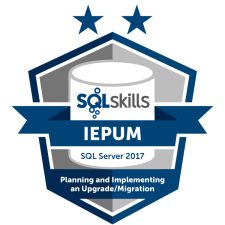IEPUM2017:
Immersion Event on Planning and Implementing
an Upgrade/Migration to SQL Server 2017
(Retired – no longer offered as a public class)
Overview
This 1-300-level, live, online training class is designed to help you justify, plan, and implement a successful upgrade and migration from a legacy version of SQL Server to SQL Server 2017, with a wealth of practical techniques that you can use as soon as you return to work. Our aim is that you can apply what we teach you to any upgrade and migration situation and justify your solution to your peers, management, or clients (yes, we welcome SQL Server consultants in our classes).
We’ll start by covering license, feature, and performance differences between SQL Server 2017 Standard Edition and SQL Server 2017 Enterprise Edition and you’ll get extremely useful information about new features in SQL Server 2016 and 2017 to help you make the technical and business case for an upgrade. We’ll show detailed information about how to select and configure your hardware and storage to maximize your performance and minimize your SQL Server license costs, whether it is deployed bare-metal on-premises, virtualized on-premises, or in a Windows Azure VM (IaaS).
We’ll next cover how to properly install and configure SQL Server 2017 for the best performance and reliability and explain and demonstrate how to use the Microsoft Data Migration Assistant and the Microsoft Database Experimentation Assistant to help discover issues that could prevent a successful upgrade and migration. Finally, you’ll learn how to plan for the migration to the new instance and the various methods you can use to migrate successfully with minimal downtime and no data loss, plus essential post-migration tasks.
All these topics will be addressed on multiple fronts: with planning and implementation considerations and techniques, common problems, troubleshooting, and multiple demonstrations. By dedicating only 3 half-days of your time for 9 hours of lecture and up to 4.5 hours of open Q&A, this is an amazing ROI while you can still get work done during your day!
This class will cover SQL Server 2005 through SQL Server 2017, and is essential for anyone responsible for upgrading to one of the latest SQL Server versions.
This class is delivered live via online streaming.
Instructor: Glenn Berry
Need Help Justifying Training? Here’s a letter to your boss explaining why SQLskills training is worthwhile and a list of community blog posts about our classes.
Ready to register? Please see our Immersion Events Schedule for class dates and registration details.
Select Quotes From Past Attendees of Glenn’s Classes
- “Glenn is always so patient in answering my numerous questions.”
- “Course information was very relevant since we are in the midst of migating our on-premise production environment to the cloud and upgrading to SQL Server 2016 or 2017.”
- “Customers stories were a nice complement to the materials.”
- “Great info for installing from the ground up.”
Curriculum
Module 1: Upgrade Planning
Understanding the technical and business benefits of an upgrade to a newer version of SQL Server are a critical part of making a compelling case for an upgrade. Topics covered include:
- License differences between Standard and Enterprise
- Feature differences between Standard and Enterprise
- Performance differences between Standard and Enterprise
- Making the case for an upgrade
- What’s new in SQL Server 2017
Module 2: Hardware and Storage Selection
Understanding how to properly select hardware to get the best performance possible, while also minimizing your SQL Server license costs is an important part of the upgrade process. After you have selected your hardware, making sure it is properly configured is vital for the best performance and scalability. Also, selecting the right type of storage and making sure it is configured and tested properly is also very important (and often ignored). Topics covered include:
- Choosing hardware to minimize licensing costs
- Choosing hardware to enable consolidation or virtualization
- Choosing storage to meet your architecture and performance requirements
Module 3: SQL Server 2017 Installation and Configuration
SQL Server 2017 is deceptively simple to install, yet a default installation has a number of issues that can reduce your performance and reliability. Knowing what needs to be changed and how to do it as part of your standard provisioning process is very useful. Topics covered include:
- GUI installation
- Updating SQL Server
- Best practice configuration settings
Module 4: Upgrade Testing
Testing your databases for an upgrade is critical to having a successful migration. You need to test for compatibility, user acceptance, performance impacts and more. Topics covered include:
- Microsoft Data Migration Assistant
- Microsoft Database Experimentation Assistant
- Finding upgrade blockers
- Application testing methods
- Checking for performance regressions due to the new Cardinality Estimator
- Alleviating performance regressions
Module 5: Migration Planning
Preparing your existing databases for the upgrade and migration process will make the migration go more smoothly and more quickly. There are a number of preparation items that can be done before the migration to help with this effort. Topics covered include:
- Important preparation work before migration
- Index maintenance
- Backup compression and tuning
- Striped backups
- Migrating instance-level objects
Module 6: Production Migration Methods
The final step of an upgrade and migration to a new version of SQL Server is actually moving your production data to the new instance and switching over to using that new instance with no data loss and the shortest outage possible. Topics covered include:
- Backup/restore
- Using log shipping
- Using database mirroring
- Post migration tasks
- Post migration monitoring
Ready to register? Please see our Immersion Events Schedule for class dates and registration details.

